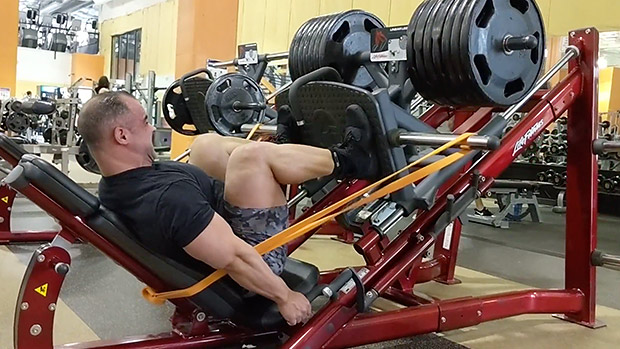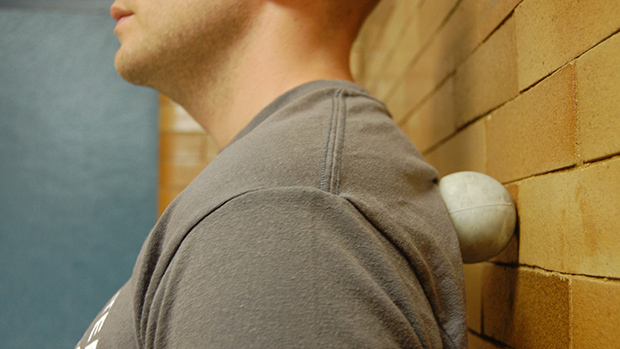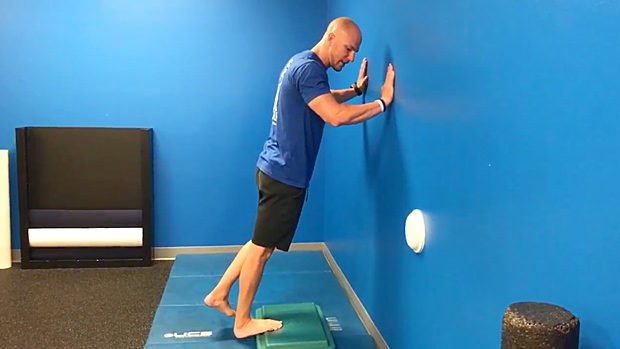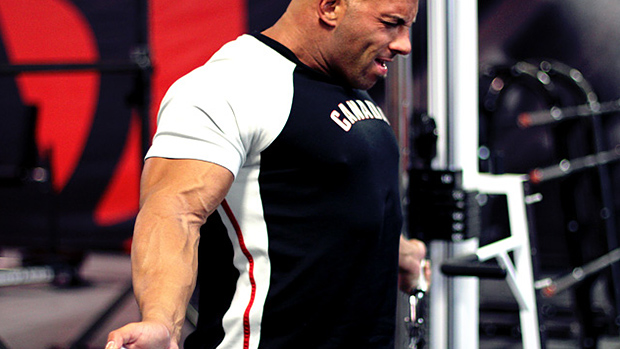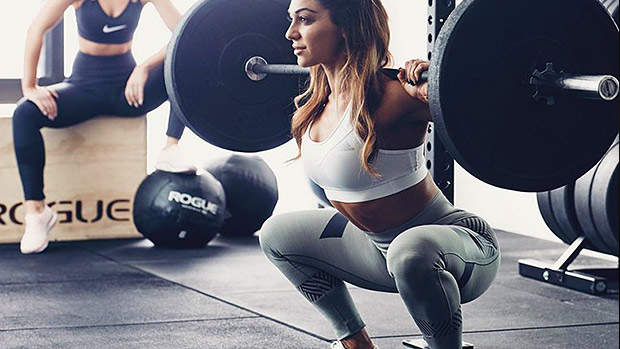A lot of people still haven't tried using bands for accommodating resistance. Too bad. Bands are easy to use and have a high payoff.
Here's how it works: You wrap a band around a barbell or machine. As the band stretches, it adds more resistance toward the end of the movement. This is perfect for exercises with a bell curve (hardest in the middle) or an ascending curve (hardest at the beginning).
The idea behind bands is to change how much resistance occurs at various points in a lift. This is often used to closer match your strength curve with the resistance curve of an exercise.
This allows for more even resistance across an exercise, ensuring you're not failing at a disproportionate weak point. You'll get thorough stimulation across different joint angles by the end of the set. This can increase hypertrophy because you'll be able to apply more resistance at angles in which your muscles might've been previously understimulated (4).
And it's not all about hypertrophy. Even athletes use accommodating resistance to boost strength and power, and break through sticking points (1,2,3).
Lastly, bands are great for allowing you to work around injuries. They activate muscles while reducing the absolute load on your connective tissues at commonly vulnerable joint angles, like the bottom of a bench press or squat. This is why adding bands tends to make movements feel smoother when you've got a nagging joint.
The best banded exercises are the ones where the band smooths out the resistance profile by accommodating it.
Banded Leg Press
- Loop a band around the back of the seat.
- Hop on the machine and loop the other end around the front of the machine.
- Leg press as you normally would.
Banded Squat
- Anchor one end of the band to a weight slightly in front of where you'd be squatting.
- Loop the other end around your neck before starting your set.
- Squat as you normally would to a comfortable depth.
- Stay stable as you stand up.
This can also be done with a cable goblet squat:
Banded Bench Press
- Anchor the band tightly behind the bench where your head rests.
- Pick your grip of choice – traditional or close grip.
- Stay tight, especially when unracking, then bench as you normally would.
Banded Dip
- Anchor a band to a weight on the floor slightly in front of you.
- Loop the band around your neck. If it's uncomfortable, wear thick clothing or just toughen up. It's not that bad.
- Keep your core tight and torso stable.
- Dip down slowly and explode up.
Banded Overhead Press
- Anchor a band to a weight on the floor slightly in front of you.
- Loop it around an empty barbell before adding plates.
- Keep your back tight.
- Press up and slightly back.
Banded Cable Press
- Loop one end of a band inside a cable hook.
- Loop the other end to the handle at the bottom of the cable.
- If there's no handle, you can simply anchor it to a weight slightly in front of you.
- Keep your back tight.
- Press up and slightly back.
Banded EZ-Bar Curl
- Anchor one end of a band to a weight slightly in front of you.
- Load the bar, then loop the other end of the band around the middle of it.
- Curl up without using momentum. Squeeze hard and hold at the top.
- Lower with control and let your biceps stretch under load.
Banded Deadlift
- Put a band over the bar. Pull both sides down until the they're relatively even.
- Step on the band and get in your preferred stance.
- Stay tight and push your feet into the band as you hinge.
Some lifts already have a descending curve – they get harder toward the end of the movement. Adding a band (or even using a reverse band setup) doesn't accommodate the exercise.
This is the rationale behind why many knowledgeable coaches frown upon adding bands to rows and extension type exercises. In doing so, you just make the easiest portion of the lift easier while making the difficult portion harder. That said, there's merit to adding bands to these exercises.
It creates a different stimulus while maintaining the same movement pattern. This is useful for advanced lifters who've plateaued during a movement and need to swap it out for a different variation between mesocycles.
I've also noticed for beginner lifters, simply adding bands (even when not biomechanically appropriate) subconsciously gets them training closer to failure. The addition of bands also provides some novelty.
So while adding them for the following exercises doesn't actually accommodate the resistance, it can still offer benefits. Check these out.
Banded Cable Pull Through
- Loop a band inside the cable hook.
- Bring the band around the rope attachment and loop the other end on the handle of the cable system.
- Walking out a couple steps and the band will stretch.
- Hinge back and forth as you squeeze your glutes at the top of the movement.
Triceps Extension
- Slightly lean your torso forward.
- Keep your body stable and extend your triceps.
- Release the eccentric with control.
Banded Hamstring Curl
- Anchor a band to a weight or plate a couple of feet in front of the machine.
- Loop the other end around the pad.
- Curl your legs down as you think about squeezing an orange underneath your knee.
- Release the eccentric with control.
Banded Leg Extension
- Loop the band around the pad.
- Find something to anchor the other end of the band towards the back of the machine.
- If it's too difficult, you can simply anchor it to a dumbbell that should fit underneath the machine.
- Grip the handles tightly before initiating the movement.
- Bring your legs up and squeeze your quads.
- Lower with control.
Bands are easy to add to exercises, so don't skip them just because you want a simpler setup. And you really only need two – one with more resistance and one with less.
The best lifts to add them on are squats, presses, deadlifts, and curls. Adding them elsewhere can be useful (and even fun) too, but start with these basics and you'll begin noticing other exercises that'd benefit from a little more accommodating resistance.
- Ataee J et al. Effectiveness of Accommodation and Constant Resistance Training on Maximal Strength and Power in Trained Athletes. PeerJ. 2014 Jun 17;2:e441. PubMed.
- Anderson CE et al. The effects of combining elastic and free weight resistance on strength and power in athletes. J Strength Cond Res. 2008 Mar;22(2):567-74. PubMed.
- Kompf J et al. Understanding and Overcoming the Sticking Point in Resistance Exercise. Sports Med. 2016 Jun;46(6):751-62. PubMed.
- Wallace BJ et al. Muscular Bases and Mechanisms of Variable Resistance Training Efficacy. International Journal of Sports Science & Coaching. 2018;13(6):1177-1188.

